Note
Access to this page requires authorization. You can try signing in or changing directories.
Access to this page requires authorization. You can try changing directories.
Azure DevOps Services | Azure DevOps Server 2022 - Azure DevOps Server 2019
Stay informed about changes to specific work items or pull requests by using the Follow feature. This feature provides targeted notifications on a case-by-case basis, helping you track items that matter most to your work without information overload.
Tip
Quick start: Select the ![]() Follow icon on any work item or pull request to start receiving notifications when it changes.
Follow icon on any work item or pull request to start receiving notifications when it changes.
What you can do with the Follow feature
- Track specific items: Get notifications only for work items and pull requests you choose to follow
- Customize notifications: Choose when to receive alerts (all changes, mentions only, or specific field updates)
- Query followed items: Use the
@Followsmacro to create custom queries and dashboards - Stay focused: Avoid notification overload by following only what matters to your work
How following differs from subscriptions
| Feature | Following | Notification Subscriptions |
|---|---|---|
| Scope | Individual items you select | Broad criteria across projects |
| Setup | One-click on specific items | Configure rules and filters |
| Best for | Tracking specific work items/PRs | Automated team workflows |
| Examples | Following a bug you reported | All items assigned to you |
For automated notifications based on broader criteria, see Manage personal notifications.
Prerequisites
| Category | Requirements |
|---|---|
| Permissions | - To view, follow, and edit work items: View work items in this node and Edit work items in this node permissions set to Allow. By default, the Contributors group has these permissions. For more information, see Set work tracking permissions. - To add tags to work items: Project-level Create new tag definition permission set to Allow. By default, the Contributors group has this permission. |
| Access levels | - Project member. - To add new tags to work items or to view or follow pull requests: At least Basic access. - To view or follow work items: At least Stakeholder access. For more information, see About access levels. - All project members, including members in the Readers group, can send emails containing work items. |
Note
- Provide Stakeholder access to members who want to contribute to the discussion and review progress. These members typically don't contribute to code, but want to view work items, backlogs, boards, and dashboards.
- By default, all Contributors and Stakeholders in public projects can add new and existing tags. In private projects, Stakeholders can only add existing tags. To control the ability to create new tags, set the Create tag definition permission at the project level. For more information, see Change project-level permissions.
Note
- Provide Stakeholder access to members who want to contribute to the discussion and review progress. These are typically members who don't contribute to code, but want to view work items, backlogs, boards, and dashboards.
Follow a work item
Quick steps: Select the ![]() Follow icon on any work item to start receiving notifications.
Follow icon on any work item to start receiving notifications.

Customize your notification preferences
Select the ![]() Settings icon next to Follow to choose when you get notified:
Settings icon next to Follow to choose when you get notified:
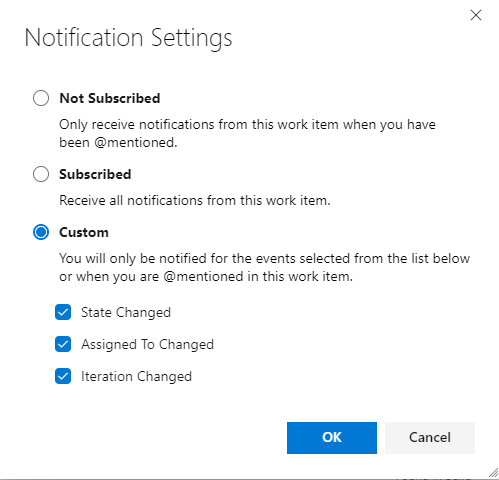
| Option | When you're notified | Best for |
|---|---|---|
| Subscribed (default) | Any change to the work item | Items you actively work on |
| Not Subscribed | Only when you're @mentioned | Items you want to watch passively |
| Custom | When specific fields change | Critical updates only |
Custom notification triggers:
- State changes: When status updates, for example, New → Active → Resolved
- Assignment changes: When someone new is assigned
- Iteration changes: When moved to different sprint
What triggers notifications
You receive email notifications when team members make the following actions:
| Action | Example |
|---|---|
| Comment or discuss | Add comments, @mention you, start discussions |
| Update fields | Change title, description, priority, tags |
| Modify attachments | Add screenshots, documents, or remove files |
| Change relationships | Link/unlink work items, update parent/child |
Note
You don't receive notifications for changes you make yourself.
Quick tip: Change your email preferences at Change your preferred email address.
To stop following: Select the ![]() Following icon.
Following icon.
Follow a pull request
Quick steps: Go to any pull request → ![]() More actions →
More actions → ![]() Follow.
Follow.
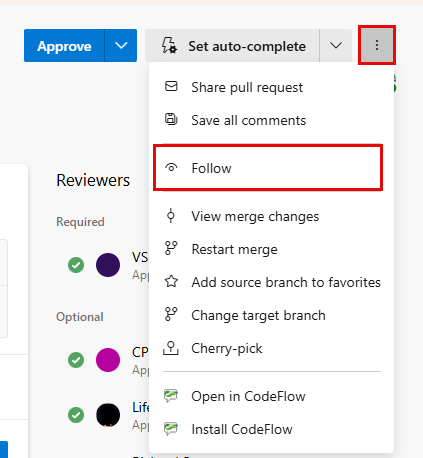
Pull request notifications
| When | What happened | Why it matters |
|---|---|---|
| Comments added | Someone reviews or discusses code | Stay informed about feedback |
| Review status changes | Approved, changes requested, or new reviewers added | Track review progress |
| Code updates | New commits pushed to the branch | See latest changes |
| Status changes | PR completed, abandoned, or reopened | Know the final outcome |
Note
Like work items, you don't get notified about changes you make yourself.
To stop following: Open More actions → select ![]() Following.
Following.
View and manage items you're following
Option 1: Quick access via Queries
Path: Boards → Queries → All → My Queries → Followed work items
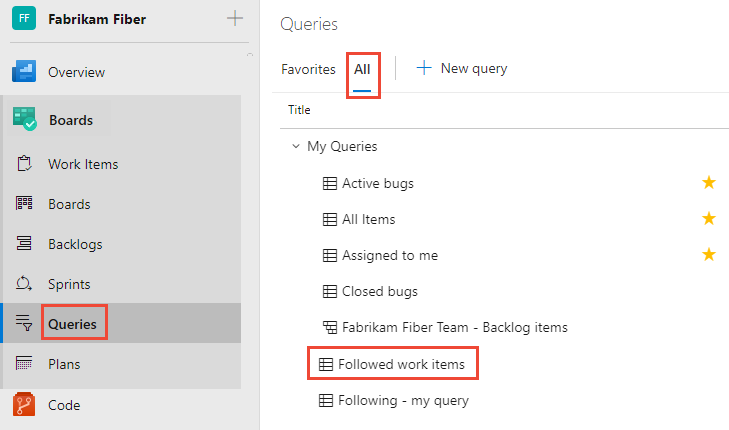
What you can do here:
- See all followed items across projects
- Sort and filter by any field
- Add custom columns
- Open items for quick review
Option 2: Work Items hub
Path: Boards → Work Items → Following tab
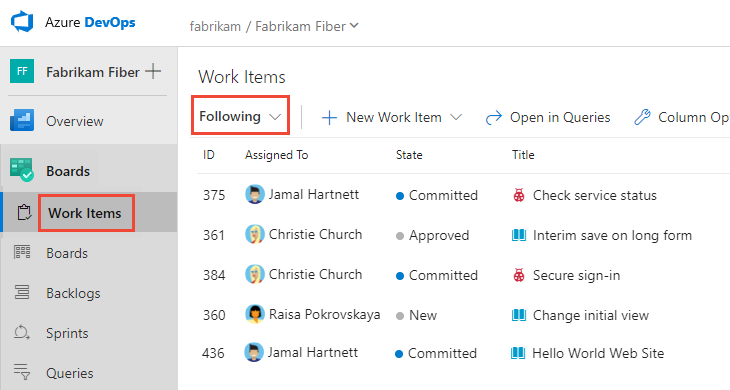
Best for: Streamlined view focused only on items you're following.
Create custom queries with @Follows
Use the @Follows macro to build powerful queries that combine items you're following with other criteria.
Basic @Follows query
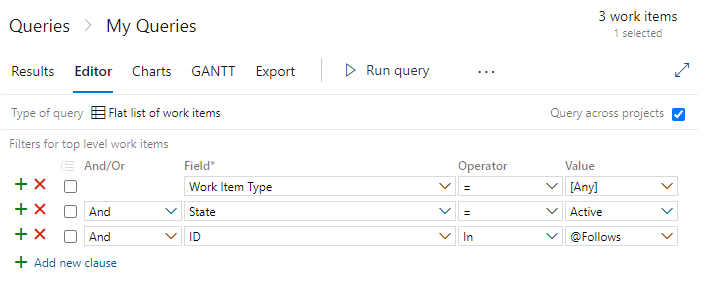
Steps:
- Create new query: Boards → Queries → New query
- Add clause: ID In @Follows
- Save and run
Advanced query examples
Most useful queries:
| Query purpose | Query clauses | Why it's helpful |
|---|---|---|
| High-priority items I'm following | ID In @Follows AND Priority = 1 |
Focus on critical items |
| My team's followed items | ID In @Follows AND Assigned To In Group [Team] |
Team collaboration |
| Recently updated | ID In @Follows AND Changed Date >= @Today - 7 |
See recent activity |
| Blocked items I follow | ID In @Follows AND State = Blocked |
Track impediments |
Tip
Share query structures: While @Follows is personal to you, you can share query templates with teammates to create consistent follow-up workflows.
Frequently asked questions
Q: Can I add someone else to follow a work item or PR?
A: No, following is personal - each user must follow items themselves. However, you can:
- Share the item link and ask them to follow it
- Set up team notifications for broader automatic alerts
- Create shared queries that include @Follows for team visibility
For team-wide notifications, see Manage team notifications.
Q: Will I get too many notifications if I follow many items?
A: You can control notification volume by:
- Using Custom notification settings for specific field changes only
- Setting items to Not Subscribed (mentions only) for passive monitoring
- Creating queries to review followed items in batches instead of individual emails
Q: Can I follow items across different projects?
A: Yes! The Follow feature works across all projects in your organization. Use the Followed work items query to see everything in one place.